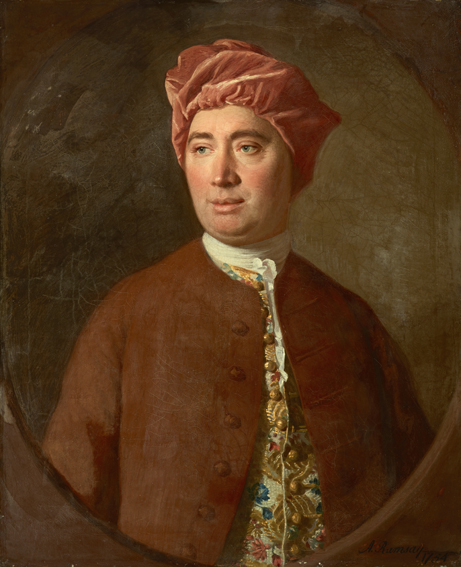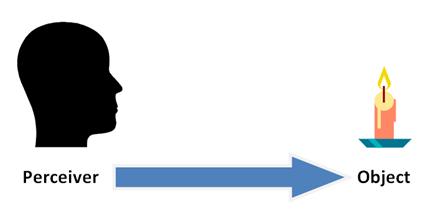 ディビッド・ヒューム
ディビッド・ヒューム感覚与件
Sense data, センス・データ
解説:池田光穂
我々の「感覚」を通して、直接体験できるものをさす。つまり、センス・データとは「感覚に与えられたもの」ということになる。人間は、世界に実在している対象や事態の 影響を受けながら、ものと見、かつ世界を体験している。私が見ているこの世界は、私の知覚体験にほかな らない。したがって、我々は世界にあるモノについて直接知っているわけではなく、我々の感覚を通したもの、すなわち感覚与件(センスデータ)を知覚してい るのである。
感覚与件の存在を無視し、我々は世界につ いて「あるがまま」の姿を理解できるという立場を、哲学では素朴実在論(naive realism)と呼んできた。感覚与件に関する伝統的な議論はディビッド・ヒューム(David Hume, 1711-1776)にみられるものである。
デイヴィッド・「ヒュームは、素朴実在論が間違っていることはあまりに明らかであるから、それを論破することをためらういわれはないと考え た。……もし素 朴実在論に傾きそうになったら、ただ一方の眼球を押してみるだけでそれを捨てることできると、と。眼球を押すと、すべてが二重に見える。ヒュームによれ ば、ここで素朴実在論は、宇宙に含まれる物体の数が二倍になったのだと結論しなければなくなるだろう。しかし、どう見ても二倍になったわけではない。従っ て私たちは直接物質的対象を見てはいないことになる、とヒュームは考えた」(サール 2006:335)[A Treatise of Human Nature, 1951:210-211]
 ディビッド・ヒューム
ディビッド・ヒューム
しかし、感覚与件を素直に受け入れると、 実際には知覚できない世界との感覚与件との関係について、どう理解すべきなのかという問題が生じる。
ジョン・ロック(John Locke, 1632-1704)は、現実世界に対応する感覚与件(センスデータ)と、そうでないものを区別すべきだと主張し、感覚与件の、一次的性質、二次的性質と 呼び分けた。 しかし、実際にどのように区分することになると難問が生じるからである。
"[M]ost sense data theorists will agree that physical objects, like sense data, have shapes, though they will typically deny that physical objects have colors or other secondary qualities (Locke 1689, II.viii; Jackson 1977, 120–37)"; Locke, John, 1689. An Essay Concerning Human Understanding, edited by Peter Nidditch, Oxford: Clarendon: 1975., Jackson, Frank, 1977. Perception: A Representative Theory, Cambridge: Cambridge University Press.[Souce of this citation]
センスデータ論者の多くは、センスデータのような物理的対象が形状を持つことに同意するが、物理的対象が色や他の二次的性質を持つことは否
定するのが普通である。
 ジョン・ロック(John Locke, 1632-1704)
ジョン・ロック(John Locke, 1632-1704)
ジョージ・バークリー(1685- 1753)は、感覚与件を否定することはなかったが、経験を超えた物質対象というものは存在しないと主張した (バークリーは感覚与件という用 語は使わず、「感じうる観念("sensible ideas")」 と読んでいる)。[下記の引用の出典:George Berkeley, A Treatise Concerning the Principles of Human Knowledge. 1710]
 ジョージ・バークリー(George Berkeley,
1685-1753)
ジョージ・バークリー(George Berkeley,
1685-1753)
57. BUT WHY THEY SHOULD SUPPOSE THE IDEAS OF SENSE TO BE EXCITED
IN US BY THINGS IN THEIR LIKENESS, and not rather have recourse to
SPIRIT which alone can act, may be accounted for, FIRST, because they
were not aware of the repugnancy there is, (1) as well in supposing
things like unto our ideas existing without, as in (2) attributing to
them POWER OR ACTIVITY. SECONDLY, because the Supreme Spirit which
excites those ideas in our minds, is not marked out and limited to our
view by any particular finite collection of sensible ideas, as human
agents are by their size, complexion, limbs, and motions. And thirdly,
because His operations are regular and uniform. Whenever the course of
nature is interrupted by a miracle, men are ready to own the presence
of a superior agent. But, when we see things go on in the ordinary
course they do not excite in us any reflexion; their order and
concatenation, though it be an argument of the greatest wisdom, power,
and goodness in their creator, is yet so constant and familiar to us
that we do not think them the immediate effects of a Free Spirit;
especially since inconsistency and mutability in acting, though it be
an imperfection, is looked on as a mark of freedom.
しかし、なぜ、感覚的な観念が、類似したものによって私たちの中に励
起されると仮定し、むしろ、唯一作用することができる精神に頼らなかったのか、その理由は、第一に、(1)私たちの観念と類似したものが存在しないと仮定することと同様に、(2)それらの力にまたは活動性を帰属させることにある矛盾に気づいていなかったからであると
考えられる。第二に、私たちの心にそれらの観念を呼び起こす至高の霊は、人間の代理
人がその大きさ、顔色、手足、運動によって示されるように、感覚的観念の特定の有限な集合によって示され、私たちの視界に制限されないからである。
そして第三に、主の活動は規則的で均一であるためである。自然の流れが奇跡によって中断されるたびに、人は優れた代理人の存在を認める用意がある。しか
し、物事が普通に進行しているのを見ても、私たちは何の考察もしない。その秩序と結
合は、その創造主における最大の知恵、力、善の証拠ではあっても、私たちにとってはあまりにも不変で慣れ親しんでいるため、それが自由意志の直接的な影響
だとは思わない。特に、行動における矛盾や変移は、不完全ではあって
も自由の証と見なされるからである。
144. But, nothing seems more to have contributed towards
engaging men in controversies and mistakes with regard to the nature
and operations of the mind, than the being used to speak of those
things in terms borrowed from sensible
ideas. For example, the will is termed the motion of the soul;
this infuses a belief that the mind of man is as a ball in motion,
impelled and determined by the objects of sense, as necessarily as that
is by the stroke of a racket. Hence arise endless scruples and errors
of dangerous consequence in morality. All which, I doubt not, may be
cleared, and truth appear plain, uniform, and consistent, could but
philosophers be prevailed on to retire into themselves, and attentively
consider their own meaning.
しかし、心の性質や働きに関して、人を論争や間違いに巻き込むのに、
感覚的な観念から借用した用語でこれらのことを語ることほど貢献したものはないように思われる。例えば、意志は魂の運動と呼ばれる。このことは、人間の心は運動するボールのようなもの
で、ラケットのストロークによってそれが必然的に決まるように、感覚の対象によって駆り立てられ、決まるという信念を植え付けるものである。それゆえ、道
徳において、危険な結果をもたらす無限の疑念や誤りが生じる。哲学者が自分自身の中
に閉じこもり、自分自身の意味を注意深く考えるように説得することができれば、これらの問題はすべて解決され、真実は明白で、均一で、一貫したものに見え
るようになるのではないだろうか。
バークリーによる神の存在証明の命題は、esse est
percipi
(存在は知覚なり)で表現される。人間や神によって、外的世界は知覚されているのだから、外的世界は存在しているという立場である(→「観念連合論者たち」)。
ヒュームは、これに対して現象主義 (phenomenalism)とも言うべき立場をとり、現実の物質的対象は、我々の感覚与件の集合の中にあ り、心的現象を超えるような存在などはないと主張した。
◎ウィトゲンシュタインの「感覚記号 E」について
「センス・データ“Sense data”」(単数形では「センス・データム」)とは、哲学の専 門用語で、「感覚に与えられたもの」を意味する。センス・データとは、知覚する主体である私たちが、知覚体験の中で、「このような物体や性質が存在する」 と推論したり、判断したり、肯定したりする認知行為に先立って、直接的に認識するものである。視覚では、感覚データは通常、色や形を示すパッチとして表現 される。他の感覚では、音、味、におい、触覚などがそれにあたる。例えば、茶色いテーブルの上に白いコースターが置いてあるとする。そのようなデータに基 づいて、茶色いものと白いもの、あるいはテーブルとコースターが目の前に存在することを肯定するようになるかもしれない。 20世紀初頭から、「センス・データ」という概念は、知識論や知覚経験の存在論の議論において中心的な役割を果たすようになった。認識論では、感覚データ は他のすべての感覚的知識の基礎として提供された。感覚データは認識論的に特権的なものであり、多くの著者は自分の感覚データについて誤ることはないとし た。センスデータとは何か(その存在論)については、コンセンサスの変化があった。初期のセンス・データの提唱者たちは、センス・データは心とは独立した もの、つまり心とは別に存在するものであり、精神的なものでも物理的なものでもない特別なものだと考えていた。20世紀後半になると、センスデータは心に 依存するもの、つまり知覚経験の中で私たちが直接認識する心的な対象や内容として捉えられるようになった。センスデータは、20世紀前半の知覚に関する議 論の主流であった。この概念は現在、知覚の哲学において、避けるべき立場の例として、しばしばつけ馬のように使われている。 本エントリではまず、「感覚データ」という用語の古典的な意味と、「感覚的所与」という概念について検討する。その後、近世から20世紀半ばまでのこれら の概念の歴史を追い、センスデータの人気の衰退につながった主な批判的反応に目を向ける。最後に、センス・データに関する最近の議論を考察し、センス・ データ理論を、感覚的印象を持つことと個々の物体の知覚とを区別する、より大きな知覚理論の属性の中に位置づけることで結論づける。 |
|
| 1. センスデータの古典的概念: 用語と概念 現在の視覚体験を考えてみよう。あなたが庭のテーブルに座っているとする。あなたはテーブルの上の物や、近くの花壇の花の鮮やかな色を見ている。茶色い庭 のテーブルの上に白いコースターが置かれ、コースターのすぐ向こうにカットされたヒナギクが咲いている。この場面のセンス・データは、すぐに経験した特定 の形と色、例えば、あなたの正面に見える白い斑点である。あなたはコースターを約45度の角度から見ている。この角度では、多くの観察者が楕円形の白い形 が一瞬見えたと報告している。(テーブルの上に置かれた丸いコースターを、この角度で観察してみてください。これからわかるように、このパッチが楕円に見 えることに誰もが同意するわけではない。)この角度では、多くの人が一瞬の視覚体験を台形の茶色の広がりを含み、台形の大きな底辺が自分に向かっていると 表現する。ヒナギクは、黄色で丸い形、白い花びらの形、緑の葉と茎の形という具体的な感覚データを提示する。 これらの感覚データの説明は、基本的な視覚的特性である色と形に焦点を当てている。通常の感覚データ理論では、私たちがテーブルやコースターやデイジーを 見ているという事実は、与えられるものの一部ではない。したがって、コースターの上に置かれたマグカップによってデイジーが部分的に隠されていたとして も、マグカップの形の両側に、感覚データの中に緑色の形が2つ存在することになり、一方が他方に属しているという認識はない。視聴者は通常、特定の物体が 存在することを認識している。その場合、センス・データを超えて、さまざまな種類のモノやコト(テーブル、コースター、花)を知覚していることになる。 センス・データ」という専門用語は、20世紀初頭の数十年間、G・E・ムーアとバートランド・ラッセルによって哲学界で注目され、その後、C・D・ブロー ド、[1] H・H・プライス、A・J・エイヤーらによって、その概念の精緻化と修正が激しく行われた。センス・データの提唱者たちは様々な点で意見を異にしたが、主 に以下の点で意見が一致した: 知覚において、われわれは感覚データを直接かつ即座に認識する。 この認識は、データムとの直接的な心的接触の関係によって生じる。 感覚データは、それが持っているように見える性質を持っている。 視覚では、形、大きさ、色などが決まっている。 このようなセンス・データの特性を認識することは、そのデータを超えた対象を肯定することでも、観念することでもない。 このような性質は、私たちには確実に(そしておそらく間違いなく)わかっている。 センスデータは私的なものである。 センス・データは、私たちがそれを認識する行為、すなわちセンス・データとは別物である。 このリストは、センス・データに関する古典的概念の基本的な分析である。項目(1)は、感覚データは他の何ものかを媒介にして知覚されるものではないとい うものである。これはしばしば、感覚データは感覚行為の直接的な対象である、という言い方で表現された。項目(2)は、感覚データと私たちの心的関係は直 接の知り合いであるとする。(3)は、ある形状の茶色い斑点を即座に感じ取った場合、私たちは、私たちの経験に存在するような現象的な茶色さと形状を持つ アイテムを知っている、というものである。つまり、物理科学的に色がどのように考えられても(例えば物体表面の微物理的性質として)、感覚データは現象的 に存在する色という性質を持っているのである。(4)は、そのような性質が確定的なものとして経験されることを示している。例えば、私たちは茶色の特定の 色合いを経験する。(5)は、色や形のような感覚的特質を認識することを、感覚データの根底に物質的対象(あるいは他の実体)が存在するかもしれないとい う判断や肯定から区別している。(6)は、知覚者はそれぞれ、ある形状の茶色い色について確信を持っており、より強いバージョンでは、経験した茶色い色の インスタンスが存在することを誤ることはできないと主張する。(7)は、感覚データは私的なもの、あるいは私的な空間に存在するものであり、ある知覚者に とっては感覚データは互いに関連しうるが、ある知覚者の感覚データは他の知覚者の感覚データとは直接的な関係にはないとする。(8)は、感覚データは、そ れを知覚するための心的行為とは別個のものである、と言っている。古典的概念では、これは一般的に、感覚データは心に依存するものではなく、独立したもの である、ということを含んでいた。 上記に含まれていないいくつかの事柄に言及することは有益であろう。センス・データは即座に認識される対象として記述されているが、それゆえ我々はセン ス・データのみを即座に認識し、外部の対象は即座に認識しないという記述はない。さらに、感覚データが二次元なのか、奥行きを含むものなのかについても明 記されていない。初期の理論家たちは通常、二次元のデータであると主張しているように読まれているが[2]、プライス(1932: 3, 218-220)を含む第二の波は、いくつかのデータに奥行きを与えている。この点については意見の相違があったため、感覚データがその瞬間的な感知を越 えて持続するかどうかについての記述はない。また、その起源についても、因果的なものであれ、そうでないものであれ、何の主張もない。感覚データは物体に よって引き起こされ、現実の外観としてそれらの物体に関連していると考えるのは自然なことであり、一部の著者はその立場を表明している(例えば、 Russell 1912: ch. 1; Broad 1923: 237-240)。しかし、そのような考え方は、初期に合意された感覚データの属性には含まれていない。同様に、項目5は、感覚データを物質的対象や他の 実体のそれと区別するものであり、そのような対象が感覚データから推論されるのか、推論ではない認識行為によって肯定されるのか、あるいは他の方法で扱わ れるのかについては何ら立場をとらない。また、項目5は、感覚データが、判断や肯定といった行為とは無関係に、対象やその特性を表すかどうかについても述 べていない。さらに、センス・データが神経生理学的状態(残像を生成するような状態)によって条件づけられることを認める著者がいたとしても、センス・ データは特定の神経生理学的プロセスと結びつけられてはいなかった。最後に、ナイーブな実在論者は、物体の表面の一部を知覚することを、知覚的データとし て表現することもあった。現在の知覚の哲学の分類学では、ナイーブな直接実在論と感覚データ論が対比されるのが一般的であるが、これは感覚データを心的な ものとして扱う現在の傾向の結果でもある(Crane & French 2015 [2021])。しかし古典期には、感覚データは物質的対象物の表面の一部を直接知覚したものであるという趣旨の議論があり(Moore 1918-19: 23-24)、Price (1932: chs. 2-3) はこの立場を説明し、弱めようとしていた。 上記の古典的観念の記述では、感覚データの形而上学的分類については何も明言されていない。それらは事象であるかもしれないし、物質であるかもしれない し、物質の状態であるかもしれないし、物理的であるかもしれないし、精神的であるかもしれない。前述のように、当初の議論に関わった著者の大半は、感覚 データは精神的なものではないとした。しかし、理論家の中には、たとえさらなる議論によってセンス・データは精神的なものではないという見解が導かれたと しても、基本的な意味における「センス・データ」という用語は、存在論において中立的なものとして扱われるべきであると忠告する者もいた(例えば、 Moore 1913-14; Price 1932: 18-20)。中立主義者にとって、感覚データが存在することを認めることは、ナイーブ実在論、代表的実在論、バークレー的観念論、カント的超越論的観念 論などの知覚存在論の諸理論と両立するはずである。 感覚データは心とは無関係であると考える初期の理論家たちは、通常、感覚データは時間を通じて持続すると考えていた。ラッセルは初期の感覚データに関する 著作(1912: ch.1)において、このようなデータを、(物理的なテーブルのような)物体や知覚者の精神状態に加えて、(精神的でも物理的でもない)特別な種類のもの (一般に「第三のもの」(tertium quid)と呼ばれる)として、心とは別に存在すると考えていた。このような仲介的な第三のものは、それを感知する行為においてのみ認識論的に与えられる かもしれないが、その存在をその行為に依存することはない。このため、感知されない感覚データ(例えば、心に依存しない色の斑点)という概念が生まれた。 このような感覚データは、誰かが適切な場所にいれば感知できるが、どのような場合でも存在することを示すために「センシビリア」と呼ばれることもあった (Russell 1914b: sec.) 20世紀後半になると、感覚データは主に精神に依存するものと見なされるようになり、それらは我々が直接認識する精神的な対象や内容であると考えられるよ うになった。したがって、コースター状のパッチの白い形は、経験される心的対象の性質であり、それは心的状態そのものがその性質の中に白くて丸みを帯びた 色のパッチを持つことを意味すると考えられた(Jackson 1977: chs.) 感覚データの最初の措定は、感覚知覚とその対象に関する現存する議論の中で生まれた。19世紀末のオックスフォードやケンブリッジでは、知覚を「外界の問 題」の一部として論じるのが一般的だった。この問題は、デカルト以降の近代哲学に見られる認識論的な問題で、自分の心を超えた外界を私たちは知っているの か、もし知っているとすれば、どうやって知っているのかという問題である。このような議論では通常、感覚と知覚の区別が想定され、それは後に感覚データと 物質的対象の知覚の間に引かれるものと多くの点で似ている。視覚がどのように生じるかについての標準的な説明では、まず感覚神経の刺激によって形や色の感 覚が生じ、そのような感覚から、おそらくは判断の過程を経て、あるいは感覚同士の関連付けを学習することによって、知覚者が対象物の知覚を形成する、とい うことになる。次に、感覚と知覚の理論の歴史と、感覚データの台頭について説明しよう。 |
|
| 3. 主な批判や反論 センス・データのトピックは20世紀中頃の数十年間に盛んに議論され、いくつかの注目すべき批判が発表された[19]。 感覚データに批判的なオースティンのオックスフォードでの講義(1947年から)は1962年に『感覚と感覚論』として出版された。彼らは次のような教義に狙いを定めていた。 われわれは物質的な対象(あるいは物質的なもの)を見たり感じたり(あるいは「感じ」たり)することはない、とにかくわれわれは物質的な対象(あるいは物質的なもの)を直接感じたり感じたりすることはない、しかし感覚データだけはある。(1962: 2) オースティンは、エイヤー(1940)やプライス(1932)などが、理解不十分な少数の単語や「中途半端に研究された『事実』」を分析する「学問的」見解を受け入れていると非難している。これとは対照的に、彼は次のように約束する。 そして、知覚の事実は、たとえば心理学者によって発見されるだけでなく、一般の人間によっても指摘されるように、これまで認められてきたよりもはるかに多様で複雑である。(1962: 3) オースティンの批判は、問題はすべて用語学的であるというエアーの意見に反対しながらも、言語使用に焦点を当てている(Austin 1962: ch. 6)。彼はエアーの「錯覚からの議論」に注目し(プライスも引用している)、楕円に見える1円玉のような知覚の相対性や変動の通常の事例が、通常は錯覚と は見なされないことに不満を述べている。実際、これまで見てきたように、以前の感覚データ理論家の多くはこれに同意している。オースティンは、古典的な議 論から知覚の変動からの議論についてほとんど述べていない。というのも、猫のような多くの対象はそうではないのに対して、小銭は安定した、境界のはっきり した形をしているからである。ある場合において、感覚データムのような特別な実体を導入することで、対象と知覚との間の不一致を説明するのであれば、現象 的に類似した場合には、直接的で真実な知覚は得られないことを受け入れなければならない、というものである。(この連続性の前提については、現在も論争が 続いている(Crane & French 2015 [2021]を参照)。より一般的には、感覚データ論者は、1セント硬貨から得られる楕円形の外観を記述する際に、(1)楕円形の物質的対象が存在するこ とを必要としないが、(2)楕円形の感覚データが存在することを肯定する「見る」という特別な感覚を採用していると主張していた(1962: ch. 3)。オースティンは、このような場合、楕円形の何かが見えなければならないと否定しているが、これは通常の言語に基づくものである。しかし、プライスや 他の人たちは、異なる知覚の言葉を忠告的に区別したのであり、オースティンは彼らの理由にもっと直接的に関与していない。さらにオースティンは、我々が物 質的なものを知覚するのは感覚データを感知した結果であるとする理論家(例えば、Broad 1923: 248)を考慮していない。 センス・データ理論に対するもう一つの挑戦は、「センス・データの誤謬」(Chisholm 1957: 151-152)を明らかにしようとするものであった。この誤謬は、何かがある特定の形(例えば、プライスの球が作り出す平らな円)に見えるなら、そのよ うな形をしている何か(センス・データム)が存在するはずだと単純に思い込んでしまうことにある[20]。批評家たちは、何かが楕円形(または平面)に見 えると主張するのは、単に見た目の特徴を述べているのであって、楕円形(または平面)を持つものが存在すると主張しているのではない、と反論する。結局の ところ、私たちは通常、物事が見た目どおりである必要はないと受け入れているのである。これに対して、感覚データ論者は「楕円形に見える」から「楕円形で ある」へと単純に移行するのではない、と主張されている(Smith 2002: 35-36)。むしろ、知覚の行為-対象分析(項目8)を受け入れることで、知覚の対象が直接的に理解され(項目1)、知覚の対象が見たとおりのものであ る(項目3)ことを確認することで、センスデータの措定が最も一般的に生じるのである。そして、「変化」と「錯覚」からの議論は、私たちはしばしば、楕円 に見えるペニーのように、物質的な物体に帰属する性質とは異なる性質を持つ知覚の対象を経験することがあり、錯覚(あるいは変化した見え方)と直接知覚と されるものの質的な類似性から、私たちは常に感覚データを知っていると結論づけるべきだと主張するために使われるかもしれない。このような議論には確かに 反論があるかもしれないが、「そのように見える」から「そのようである」へと単純かつ無警戒に移行することはなかった。 この誤謬を回避しようとする理論家たちは、楕円形のものが心に存在しなくても、現象的に直接的に楕円形に見えるかもしれないと考えた。これらは「外見理 論」と呼ばれることもある。そのような立場のひとつが副詞的分析であり、現象的特質は知覚の精神活動の中に存在するが、物体や性質的実体として存在するこ とはないとする。従って、私たちは1円玉そのものを知覚するが、それを丸く、あるいは楕円に、そして赤くといった特定の仕方で知覚する(Ducasse 1942; Chisholm 1957: part 3)。私たちが1円玉を楕円形に経験しているというのは、実際に楕円形のものが存在しなくても、私たちが楕円形の外観を楽しんでいるということである。む しろ、外観は単に私たちが1円玉を感じる方法として、あるいは私たちの感覚活動が1円玉の形を経験させる方法として理解される。関連する種類の外見理論で は、楕円形の外見を、内容が楕円形で赤色である心的内容、つまり意図的状態としている(Barnes 1944-1945)。したがって、実際に楕円形の物体を知らなくても、意図的な内容を介して楕円形の空間構造を経験することができる。意図的な内容は、 知覚者の状態として外観をインスタンス化し、その知覚体験は、それによって世界をある種のものとして、たとえば楕円形を含むものとして表象する。(インテ ンショナリストの理論はDretske 1995やTye 1995に見られる。重要な初期の定式化はAnscombe 1965である)。これら2つのタイプの理論は、副詞的あるいは意図的な内容を介して「変化」と「錯覚」を説明する。実際、これらの理論は、ある場合には (適度な傾きがあれば)、私たちは丸い1円玉を、視線に対して傾いている丸い1円玉として見ることができる。副詞論者は、私たちは1円玉を丸く見ていると 言い、意図論者は、私たちは1円玉が丸いことを表す心的内容を介して1円玉を見ていると言う。(これらの知覚の哲学については、Crane & French 2015 [2021]を参照)。 哲学や心理学には、貧弱で典型的な2次元の感覚内容や状態と、3次元の対象物の知覚との区別を現象論的な根拠に基づいて否定する伝統がある。ウィリアム・ ジェームズは、感覚は本質的に世界に向けられたものであり(1890, 2: 1-3)、三次元的な体積を示す(1890, 2: 135-136)と断言しているが、これは感覚データに関する古典的概念にあらかじめ異議を唱えていると見ることができる。ジェイムズは、感覚と知覚の両 方が私たちに「すぐに現前する外界の現実」(1890, 2: 2)を与えるという立場を支持し、感覚データがそれを超えた世界について中立的であるという項目5を否定している。ゲシュタルト心理学者たち (Koffka 1935: chs. 1-3; Köhler 1929 [1947: chs. 1-3])もまた、私たちが知覚的に与えられているのは世界であって、世界とは異なる貧弱な内容や対象ではないという立場を採用した。彼らは世界の価値や 機能的価値の知覚を、知覚内容の即座に与えられた側面とした。ゲシュタルト理論家は、サイズと形状の不変性という現象に注目した。同じ大きさの2つの物体 が5フィートと10フィートの地点に提示された場合、遠くの物体の網膜像は近くの物体の像の半分の大きさ(線形の高さ)になる。同様に、(中程度の)傾き で見た円は、網膜上では楕円に見えるが、円形に見える。これらの理論家は、2つの対象間の大きさの有意な現象的差異と楕円形の見え方は、特別な実験条件下 か、あるいは絵を描くことを教わった人に見られるような訓練された注意の働きによってのみ生じる、と主張した(Koffka 1935: 222-223; Köhler 1929 [1947: 71-74])。その後、知覚心理学者のジェームズ・J・ギブソン(James J. Gibson, 1950)は、感覚データのような二次元の経験は、私たちが通常知覚している三次元の視覚世界から、人為的に私たちの現象論を変化させる注意の行為から生 じると主張し、ゲシュタルト理論家に同意した。したがって、二次元の視覚野は、注意によって発見される知覚の直接的な対象や原初的な構成要素ではない。む しろ、注意の特別な努力によって構築されるのである。ギブソンは、斜めに置かれた円(例えば、晩餐会での隣人の皿)を日常的に知覚する場合、その対象は斜 めに置かれた円のように見えるので、楕円形ではなく円形に見えるとした(1950年:第1、9章)。その後の著作でギブソン(1966、1979)は、感 覚システムは知覚者にナビゲート可能な環境と、知覚者のニーズや目標を満たすためのアフォーダンスを提示するために調整されているという考え方を展開し た。 これら3つの理論的立場はいずれも、現象学的根拠に基づいて、知覚意識の二重の性格、すなわち貧弱な感覚的要素とそれに付随する解釈や対象措定への分割を 否定している。むしろ、感覚体験は本質的に世界提示的であり、(三次元的に)空間的に広がり、効用を警告するものである。 ウィルフリッド・セラーズは、主体が認識論的所与(知識の原初的基礎)をもたらすようなかたちで原子論的に反応できる純粋所与の「神話」の仮面を剥ごうと した。セラーズが高く評価した『経験論と心の哲学』(1956年)によれば、「古典的な」感覚データの立場は、「sは赤い」は非推論的に知ることができる とする。古典的センスデータ哲学者は は、所与性とは、学習も連想の形成も刺激-反応接続の設定も前提としない事実であるとしている。(1956: §6) 彼らは「矛盾した三項対立」を受け入れている: Xが赤い感覚内容sを感じると、xはsが赤いことを非推論的に知る。 感覚内容を感知する能力は未習得である。 xがφであることを知る能力は獲得される。 AとBはともにCでないことを含意し、BとCはAでないことを含意し、AとCはBでないことを含意する。 誰がこの三項対立に同意したと言われているのか?セラーズの例のいくつかは近世哲学から引用されている。彼は事実上、AとBのバージョンをロック、バーク レー、ヒュームに帰しているが(1956: §28)、Cには帰していないようである。彼はエアーの言語分析を批判しているが(1956: §8-9)、それは感覚データの話が(Aのように)認識論的に基本的であることを示すことよりも、対象の話を感覚データの話に分析することを目的としてい ることを示唆している。彼はブロード (1956: §11)とプライス (1956: §31)について簡単に言及しているが、三段論法を彼らに帰属させるものではない。彼はまた、「科学の実証主義的概念」(1956: §43)における「与えられたもの」の役割にかなりの注意を傾けており、彼の主な標的はカルナップやライヘンバッハなどが提唱した概念であったと推測した くなる。その方向性を評価するためには、実証主義者が初歩的な経験からプロトコル文へと移行したことを認識論的に基本的なことだと解釈する必要があるが、 それは私たちを大きく遠ざけることになる(ただし、Leitgeb & Carus 2020を参照)。 三段論法に関連して、ロックの著名な読解は、感覚的観念がその原因に関する知識を与えるとして、彼に認識論的権威を付与させている(Ayers 1991: vol. 1, ch. 18)。古典的な感覚データ論者の間では、Aを否定する者が多く、感覚と「知り合い」を「それを知っていること」と区別している。赤を感じることは、通 常、非推論的にsが赤であることを知ることにつながるかもしれないが、単純な連言の問題ではない。ラッセルはAを明確に否定した。感知は未習得かもしれな いが、「それを知る」には単なる感知ではなく判断が必要であり、感覚の質の判断に入る普遍性(白さなど)は後天的なものであり、Cを肯定する。セラーズ自 身はAを否定し、Bを複雑化し、Cを肯定して、「心理学的名辞論」(1956: §29)の立場を(仮定によって)採用している。それによれば、色彩用語を含む種類用語と色彩の事例を認識する能力は、言語的・概念的な意味の網の一部と して学習される(全体論)。 セラーズは色彩用語に関する全体論において、感覚データに関する原子的記述を認識論的に基本的なもの(ラッセルの心理学的・論理学的に原始的なハードデー タ)とするラッセルの概念に関わるような反論を提起した。セラーズ(1956)は、行動主義者の祖先が思考を互いの内的状態として扱い、その後に自分の思 考を自己報告することを学ばなければならないという、彼自身の精巧な神話を構築している(1956: §47-59)。彼はこの物語を、内的思考を互いに帰属させることから、内的な感覚的印象を措定することへと拡張する(1956: §60-62)。彼の見解はラッセルの立場とは異なり、赤色感覚体験を認識する能力を、洗練された意味と理論の網の獲得に依存させる。また、ラッセルが言 うように、sが赤であることを知るために必要な普遍的な赤は「容易に獲得できる」ものでもない(1912 [1997: 101])。したがって、知識を基礎づける感覚データを記述するための、容易に獲得できる色彩述語は存在しない。セラーズは次のように主張する。 私たちがその種のものに気づいたから何かの概念を持つようになるのではなく、ある種のものに気づく能力を持つことは、すでにその種のものの概念を持っていることであり、それを説明することはできない。(1956: §45) セラーズは、このような社会的な獲得過程を通じて、感覚印象が「絶対的なプライバシー」を失い、間主観的な知識の対象となるという利点を主張する (1956: §62)。しかし、彼はまた、感覚データが学習に先立って心に即座に存在するものであるという知性観も否定している(項目2)。現象的概念の獲得が感覚的 特殊の存在を観察し自己報告する能力を可能にするというセラーズの全体論的概念は、矛盾した三項対立の議論に見られるよりも、古典的観念の項目2を否定す るためのより良い理由を提供するかもしれない。 |
|
| 5. 結論 センス・データムの核となる概念は、視覚の場合、色の形からなる、すぐに与えられる最小限の知覚対象である。多くの場合(常にではないが)、このデータは 二次元であると考えられていた。一般的に、この知覚は、特定の種類で、さらにさまざまな特性を示す三次元の物質的対象物の知覚と対比された。古典的な時代 (20世紀の最初の数十年間)には、感覚データは通常、非精神的で心に依存しないものとされ、物質的な物体を表すものとみなされることが多かった。場合に よっては、感覚データやその親族は、感覚的な特殊性を構成したり束ねたりする際の要素的な構成要素であると考えられていた。これらの特殊性はそれ自体が物 質的な対象物を指すのではなく、結合することで知覚世界を構成する(ラッセル1914a、1914bのように)。より最近では、感覚データは心的項目とみ なされ(Jackson 1977など)、おそらく観念論につながると考えられている(Robinson 1994)。また、センス・データを物質的な物体の表面の一部と同一視する例もある(Moore 1918-19: 23-24; Bermúdez 2000)。 センス・データの理論は、知覚理論において、貧弱な感覚的印象と、さらなる実体(通常は物質的物体)の知覚、肯定、判断とを区別する、ある属の立場の一種 である。この区別を共有しながらも、この属の他の種は感覚データ理論とは様々な点で異なっており、最も基本的なものは、意識的知覚に見られるような色や形 の性質を持つ対象を想定していないことである(項目3)。知覚された特性を外見とみなす見解もある。あるタイプの外見理論では、形、色、その他の知覚され る物体の特性は意図的な内容であるとする(意図主義)。もう一つのタイプは、形や色の経験は知覚の作法や様式であるとする(副詞主義)。どちらのタイプの 理論の信奉者も行為-対象分析を否定するので、古典的観念の項目8を否定することになり、もちろん項目1と2も否定することになる。また、ナイーブ・リア リズム(素朴実在論)のいくつかのバージョンでは、私たちは物体の表面をある視点から3次元的に即座に知覚し、その後、概念化された物体の内容を含むよう に基本的な知覚を拡張するとする(Noë 2004, Brewer 2011)。現在のところ、これらの様々な立場は、感覚データを心的対象や第三のものとして仮定する理論よりも好意的に受け止められている。実際、知覚の 哲学における最近の議論では、避けるべき概念や実体の例として感覚データが頻繁に用いられている(例えば、Fish 2010: ch. 2)。 貧弱な感覚知覚を物体の知覚や認識から区別する理論は、ファース(1949-50)が「知覚理論」と呼んだものによって挑戦されてきた。それによれば、即 時的な視覚体験は、物体の特性や行動の可能性を明示する三次元の視覚世界である。これはジェイムズ、ゲシュタルト心理学者、ギブソン、そしていくつかの外 見理論(例えばスミス2002)の伝統である。このような理論は近年、支持を集めている。しかし、感覚データ理論もまた発展を見せている。多くの感覚デー タ理論は、知覚の直接的な対象は3次元であると認識している。そのため、適度な斜めから見た1円玉は、楕円ではなく、斜めの円として見えると説明すること ができる。最後に、色を文字通り感覚データに内在する原始的な性質として扱うことは(そのようなデータが表面部分、心的対象、あるいは第三のものであると 考えられるかどうかにかかわらず)、広く支持されているわけではないが、形而上学的に言えば、現象的に経験される色には定まった故郷がないことも事実であ る。物体とその特性の現象的特性を説明する試みは現在も続いている。 |
|
| https://plato.stanford.edu/entries/sense-data/ |
|
 naïve realism naïve realismIn philosophy of perception and epistemology, naïve realism (also known as direct realism, perceptual realism, or common sense realism) is the idea that the senses provide us with direct awareness of objects as they really are.[1] When referred to as direct realism, naïve realism is often contrasted with indirect realism.[2] According to the naïve realist, the objects of perception are not representations of external objects, but are in fact those external objects themselves. The naïve realist is typically also a metaphysical realist, holding that these objects continue to obey the laws of physics and retain all of their properties regardless of whether or not there is anyone to observe them.[3] They are composed of matter, occupy space, and have properties, such as size, shape, texture, smell, taste and colour, that are usually perceived correctly. The indirect realist, by contrast, holds that the objects of perception are simply representations of reality based on sensory inputs, and thus adheres to the primary/secondary quality distinction in ascribing properties to external objects.[1] In addition to indirect realism, naïve realism can also be contrasted with some forms of idealism, which claim that no world exists apart from mind-dependent ideas, and some forms of philosophical skepticism, which say that we cannot trust our senses or prove that we are not radically deceived in our beliefs;[4] that our conscious experience is not of the real world but of an internal representation of the world. Overview The naïve realist is generally committed to the following views:[5] Metaphysical realism: There exists a world of material objects, which exist independently of being perceived, and which have properties such as shape, size, color, mass, and so on independently of being perceived Empiricism: Some statements about these objects can be known to be true through sensory experience Naïve realism: By means of our senses, we perceive the world directly, and pretty much as it is, meaning that our claims to have knowledge of it are justified Among contemporary analytic philosophers who defended direct realism one might refer to, for example, Hilary Putnam,[6] John McDowell,[7][8] Galen Strawson,[9] John R. Searle,[10] and John L. Pollock.[11] Searle, for instance, disputes the popular assumption that "we can only directly perceive our own subjective experiences, but never objects and states of affairs in the world themselves".[12] According to Searle, it has influenced many thinkers to reject direct realism. But Searle contends that the rejection of direct realism is based on a bad argument: the argument from illusion, which in turn relies on vague assumptions on the nature or existence of "sense data". Various sense data theories were deconstructed in 1962 by the British philosopher J. L. Austin in a book titled Sense and Sensibilia.[13] Talk of sense data has largely been replaced today by talk of representational perception in a broader sense, and scientific realists typically take perception to be representational and therefore assume that indirect realism is true. But the assumption is philosophical, and arguably little prevents scientific realists from assuming direct realism to be true. In a blog post on "Naive realism and color realism", Hilary Putnam sums up with the following words: "Being an apple is not a natural kind in physics, but it is in biology, recall. Being complex and of no interest to fundamental physics isn't a failure to be "real". I think green is as real as applehood."[14] The direct realist claims that the experience of a sunset, for instance, is the real sunset that we directly experience. The indirect realist claims that our relation to reality is indirect, so the experience of a sunset is a subjective representation of what really is radiation as described by physics. But the direct realist does not deny that the sunset is radiation; the experience has a hierarchical structure, and the radiation is part of what amounts to the direct experience.[12] Simon Blackburn has argued that whatever positions they may take in books, articles or lectures, naive realism is the view of "philosophers when they are off-duty."[15] History For a history of direct realist theories, see Direct and indirect realism § History. Scientific realism and naïve perceptual realism Many philosophers claim that it is incompatible to accept naïve realism in the philosophy of perception and scientific realism in the philosophy of science. Scientific realism states that the universe contains just those properties that feature in a scientific description of it, which would mean that secondary qualities like color are not real per se, and that all that exists are certain wavelengths which are reflected by physical objects because of their microscopic surface texture.[16] John Locke notably held that the world only contains the primary qualities that feature in a corpuscularian scientific account of the world, and that secondary qualities are in some sense subjective and depend for their existence upon the presence of some perceiver who can observe the objects.[3] Influence in psychology Naïve realism in philosophy has also inspired work on visual perception in psychology. The leading direct realist theorist in psychology was J. J. Gibson. Other psychologists were heavily influenced by this approach, including William Mace, Claire Michaels,[17] Edward S. Reed,[18] Robert Shaw, and Michael Turvey. More recently, Carol Fowler has promoted a direct realist approach to speech perception. |
 素朴実在論 素朴実在論知覚の哲学と認識論において、ナイーブ実在論(素朴実在論、直接実在論、知覚実在論、常識実在論としても知られている)とは、感覚は対象をありのままに直 接認識させるという考え方である[1]。直接実在論と呼ばれる場合、ナイーブ実在論はしばしば間接実在論と対比される[2]。 ナイーブ実在論者によれば、知覚の対象は外部の対象の表象ではなく、実際には外部の対象そのものである。ナイーブ実在論者は一般的に形而上学的実在論者で もあり、これらの物体は物理法則に従い続け、それを観察する人がいるかいないかにかかわらず、すべての特性を保持し続けるとする[3]。これに対して間接 実在論者は、知覚の対象は感覚的入力に基づく現実の単なる表象であるとし、したがって外的対象に特性を帰属させる際に第一次/第二次品質の区別を堅持する [1]。 間接的実在論に加えて、ナイーブ実在論は、心に依存した観念を離れて世界は存在しないと主張する観念論や、哲学的懐疑論のいくつかの形態とも対比される。 概要 ナイーブ・リアリストは、一般的に以下のような見解を持っている[5]。 形而上学的実在論: 形而上学的実在論:知覚されることとは無関係に存在し、知覚されることとは無関係に形、大きさ、色、質量などの性質を持つ物質的な物体の世界が存在する。 経験主義: 経験主義:感覚的な経験を通じて、これらの物体に関するいくつかの記述が真であることを知ることができる。 ナイーブ実在論: 感覚によって、私たちは世界を直接、そしてほとんどありのままに知覚する。 直接実在論を擁護した現代の分析哲学者としては、例えばヒラリー・パットナム、[6]ジョン・マクダウェル、[7][8]ゲイレン・ストローソン、[9]ジョン・R・サール、[10]ジョン・L・ポロックが挙げられる。 例えばサールは、「われわれが直接知覚できるのは自分自身の主観的な経験だけであり、世界の対象や状態そのものを知覚することは決してできない」という一 般的な仮定に異議を唱えている[12]。サールによれば、この仮定は多くの思想家に直接実在論を否定するよう影響を与えている。しかしサールは、直接実在 論の否定は錯覚からの議論という悪い議論に基づいており、それは「感覚データ」の性質や存在に関する曖昧な仮定に依存していると主張している。様々な感覚 データ理論は、1962年にイギリスの哲学者J.L.オースティンによって『Sense and Sensibilia』という本の中で解体された[13]。 今日、感覚データの話は、広い意味での表象的知覚の話にほぼ置き換えられており、科学的実在論者は通常、知覚は表象的であると考え、したがって間接的実在 論が真であると仮定している。しかし、この仮定は哲学的なものであり、科学的実在論者が直接実在論を真であると仮定することを妨げるものはほとんどない。 ナイーブ・リアリズムとカラー・リアリズム」というブログ記事の中で、ヒラリー・パットナムは次のようにまとめている: 「リンゴであることは物理学では自然な種類ではないが、生物学では自然な種類である。リンゴであることは物理学では自然な種類ではないが、生物学では自然 な種類である。私は、緑色はリンゴであることと同じくらい実在すると思う」[14]。 直接実在論者は、例えば夕日の経験は、私たちが直接経験する現実の夕日であると主張する。間接実在論者は、われわれと現実との関係は間接的なものであり、 したがって夕日の経験は、物理学によって記述された、本当は放射線であるものの主観的な表現であると主張する。しかし、直接実在論者は夕日が放射線である ことを否定しない。体験には階層構造があり、放射線は直接体験に相当するものの一部なのである[12]。 サイモン・ブラックバーンは、書籍や論文、講義においてどのような立場を取ろうとも、素朴実在論は「非番のときの哲学者」の見解であると主張している[15]。 歴史 直接実在論の歴史については、直接実在論と間接実在論§歴史を参照。 科学的実在論とナイーブ知覚実在論 多くの哲学者は、知覚哲学におけるナイーブ実在論と科学哲学における科学的実在論は両立しないと主張している。科学的実在論は、宇宙には科学的記述に特徴 的な性質だけが含まれているとし、色のような二次的な性質はそれ自体実在せず、存在するのは物理的な物体の微細な表面の質感のために物理的な物体によって 反射される特定の波長だけであるとする[16]。 ジョン・ロックは特に、世界はコーパスキュラー的な科学的説明の中で特徴づけられる一次的な性質のみを含んでおり、二次的な性質はある意味で主観的なものであり、その存在は対象を観察することができる知覚者の存在に依存していると主張していた[3]。 心理学における影響 哲学におけるナイーブ・リアリズムは、心理学における視覚知覚の研究にも影響を与えた。心理学における代表的な直接実在論者はJ.J.ギブソンである。 ウィリアム・メイス、クレア・マイケルズ、[17] エドワード・S・リード、[18] ロバート・ショウ、マイケル・ターベイなど、他の心理学者もこのアプローチに大きな影響を受けている。最近では、キャロル・ファウラー(Carol Fowler)が音声知覚に対する直接実在論的アプローチを推進している。 |
| Critical realism Disjunctivism Empirical realism Qualia Phenomenology (psychology) and Phenomenology (philosophy) Plato's allegory of the cave |
批判的リアリズム 分離主義 経験的実在論 クオリア 現象学(心理学)と現象学(哲学) プラトンの洞窟の寓意 |
| https://en.wikipedia.org/wiki/Na%C3%AFve_realism |
|
| ★Phenomenalism |
★現象主義/現象論 |
| phenomenalism
In metaphysics, phenomenalism is the view that physical objects cannot justifiably be said to exist in themselves, but only as perceptual phenomena or sensory stimuli (e.g. redness, hardness, softness, sweetness, etc.) situated in time and in space. In particular, some forms of phenomenalism reduce all talk about physical objects in the external world to talk about bundles of sense data. |
現象主義/現象論 形而上学において現象論とは、物理的な物体はそれ自体として存在するこ とは正当化できず、時間と空間の中に位置する知覚現象や感覚刺激(例えば赤さ、硬さ、柔らかさ、甘さなど)としてのみ存在するとする見解である。特に、あ る種の現象論は、外界の物理的対象についての話をすべて、感覚データの束についての話に還元してしまう。 |
| History Phenomenalism is a radical form of empiricism. Its roots as an ontological view of the nature of existence can be traced back to George Berkeley and his subjective idealism, upon which David Hume further elaborated.[1] John Stuart Mill had a theory of perception which is commonly referred to as classical phenomenalism. This differs from Berkeley's idealism in its account of how objects continue to exist when no one is perceiving them. Berkeley claimed that an omniscient God perceived all objects and that this was what kept them in existence, whereas Mill claimed that permanent possibilities of experience were sufficient for an object's existence. These permanent possibilities could be analysed into counterfactual conditionals, such as "if I were to have y-type sensations, then I would also have x-type sensations". As an epistemological theory about the possibility of knowledge of objects in the external world, however, the most accessible formulation of phenomenalism is perhaps to be found in the transcendental idealism of Immanuel Kant. According to Kant, space and time, which are the a priori forms and preconditions of all sensory experience, "refer to objects only to the extent that these are considered as phenomena, but do not represent the things in themselves". While Kant insisted that knowledge is limited to phenomena, he never denied or excluded the existence of objects which were not knowable by way of experience, the things-in-themselves or noumena, though he never proved them. Kant's "epistemological phenomenalism", as it has been called, is therefore quite distinct from Berkeley's earlier ontological version. In Berkeley's view, the so-called "things-in-themselves" do not exist except as subjectively perceived bundles of sensations which are guaranteed consistency and permanence because they are constantly perceived by the mind of God. Hence, while Berkeley holds that objects are merely bundles of sensations (see bundle theory), Kant holds (unlike other bundle theorists) that objects do not cease to exist when they are no longer perceived by some merely human subject or mind. In the late 19th century, an even more extreme form of phenomenalism was formulated by Ernst Mach, later developed and refined by Russell, Ayer and the logical positivists. Mach rejected the existence of God and also denied that phenomena were data experienced by the mind or consciousness of subjects. Instead, Mach held sensory phenomena to be "pure data" whose existence was to be considered anterior to any arbitrary distinction between mental and physical categories of phenomena. In this way, it was Mach who formulated the key thesis of phenomenalism, which separates it from bundle theories of objects: objects are logical constructions out of sense-data or ideas; whereas according to bundle theories, objects are made up of sets, or bundles, of actual ideas or perceptions. That is, according to bundle theory, to say that the pear before me exists is simply to say that certain properties (greenness, hardness, etc.) are being perceived at this moment. When these characteristics are no longer perceived or experienced by anyone, then the object (pear, in this case) no longer exists. Phenomenalism as formulated by Mach, in contrast, is the view that objects are logical constructions out of perceptual properties. On this view, to say there is a table in the other room when there is no one in that room to perceive it, is to say that if there were someone in that room, then that person would perceive the table. It is not the actual perception that counts, but the conditional possibility of perceiving. Logical positivism, a movement begun as a small circle which grew around the philosopher Moritz Schlick in Vienna, inspired many philosophers in the English speaking world from the 1930s through the 1950s. Important influences on their brand of empiricism included Ernst Mach — himself holding the Chair of Inductive Sciences at the University of Vienna, a position Schlick would later hold — and the Cambridge philosopher Bertrand Russell. The idea of some logical positivists, such as A.J. Ayer and Rudolf Carnap, was to apply phenomenalism in linguistic terms, enabling reliable discourse of physical objects, such as tables, in strict terms of either actual or possible sensory experiences. 20th century American philosopher Arthur Danto asserted that "a phenomenalist, believ[es] that whatever is finally meaningful can be expressed in terms of our own [sense] experience.".[2] He claimed that "The phenomenalist really is committed to the most radical kind of empiricism: For him reference to objects is always finally a reference to sense-experience ... ."[3] To the phenomenalist, objects of any kind must be related to experience. "John Stuart Mill once spoke of physical objects as but the 'permanent possibility of experience' and this, by and large, is what the phenomenalist exploits: All we can mean, in talking about physical objects — or nonphysical objects, if there are any — is what experiences we would have in dealing with them ... ." However, phenomenalism is based on mental operations. These operations, themselves, are not known from sense experience. Such non-empirical, non-sensual operations are the "...nonempirical matters of space, time, and continuity that empiricism in all its forms and despite its structures seems to require ... ."[3] See for comparison Sensualism, to which phenomenalism is closely related. |
歴史 現象主義は経験主義の急進的な形態である。存在の本質に関する存在論的見解としてのそのルーツは、ジョージ・バークレーと彼の主観的観念論にまで遡ること ができ、デイヴィッド・ヒュームはそれをさらに推敲した[1]。ジョン・スチュアート・ミルは、一般に古典的現象主義と呼ばれる知覚理論を持っていた。こ れは、誰も知覚していないときに物体がどのように存在し続けるかという説明において、バークレーの観念論とは異なっている。バークレーは、全知全能の神が すべての物体を知覚し、それが物体を存在させ続けると主張したのに対し、ミルは、経験の永続的可能性が物体の存在に十分であると主張した。これらの永続的 可能性は、「もし私がy種類の感覚を持つならば、x種類の感覚も持つだろう」というような反事実的条件論に分析することができる。 しかし、外界の対象に関する知識の可能性に関する認識論的理論として、現象論の最もわかりやすい定式化は、おそらくイマヌエル・カントの超越論的観念論に ある。カントによれば、すべての感覚的経験のアプリオリな形式であり前提条件である空間と時間は、「これらが現象として考えられる範囲においてのみ対象を 指し示すのであって、それ自体で事物を表すものではない」。カントは、知識は現象に限定されると主張しながらも、経験によって知ることのできない対象、す なわち「それ自体におけるもの」あるいは「ヌーメナ」の存在を否定したり排除したりすることはなかったが、それらを証明することはなかった。 それゆえ、カントの「認識論的現象論」は、バークレーのそれ以前の存在論的バージョンとはまったく異なる。バークレーの見解では、いわゆる「物自体」は、 主観的に知覚される感覚の束として存在する以外には存在せず、それは神の心によって常に知覚されるため、一貫性と永続性が保証されている。したがって、 バークレーが「物」は感覚の束に過ぎないとするのに対して(束理論参照)、カントは(他の束理論家とは異なり)、「物」は単に人間の主体や心によって知覚 されなくなっても存在しなくなることはないとする。 19世紀後半、エルンスト・マッハによってさらに極端な現象論が提唱され、後にラッセル、エア、論理実証主義者たちによって発展・洗練された。マッハは神 の存在を否定し、現象が主体の心や意識によって経験されるデータであることも否定した。その代わりにマッハは、感覚現象は「純粋データ」であり、その存在 は、現象の精神的カテゴリーと物理的カテゴリーとの恣意的な区別の前にあると考えた。このようにして、マッハは、現象論と束理論とを区別する重要なテーゼ を定式化したのである。すなわち、対象は感覚データや観念から論理的に構築されたものであるのに対し、束理論によれば、対象は実際の観念や知覚の集合 (束)から構成される。 つまり、バンドル理論によれば、目の前にある梨が存在すると言うことは、ある特性(緑色、硬さなど)が今この瞬間に知覚されているというだけのことであ る。これらの特性がもはや誰にも知覚されず、経験されなくなったとき、その物体(この場合は梨)はもはや存在しないのである。マッハが定式化した現象論 は、これとは対照的に、物体は知覚特性から論理的に構築されたものであるという見解である。この考え方では、別の部屋にテーブルがあると言うとき、その テーブルを知覚する人がその部屋にいなければ、その人はテーブルを知覚するだろうということになる。重要なのは実際の知覚ではなく、知覚するという条件付 きの可能性なのである。 ウィーンの哲学者モーリッツ・シュリックを中心に小さなサークルとして始まった論理実証主義は、1930年代から1950年代にかけて英語圏の多くの哲学 者に影響を与えた。彼らの経験主義に重要な影響を与えたのは、エルンスト・マッハ(シュリックは後にウィーン大学で帰納科学の講座を担当)やケンブリッジ 大学の哲学者バートランド・ラッセルなどである。A.J.エイヤーやルドルフ・カルナップなどの論理実証主義者の考えは、現象論を言語学的に応用し、テー ブルのような物理的対象について、実際の感覚体験か可能な感覚体験かという厳密な観点から信頼性の高い言説を可能にすることであった。 20世紀のアメリカの哲学者であるアーサー・ダントは、「現象論者は、最終的に意味のあるものはすべて、我々自身の(感覚的な)経験の観点から表現できる と信じている」と主張した[2]: 彼にとって対象への言及は常に最終的には感覚経験への言及である......」[3]。 現象主義者にとっては、どのような種類の対象であれ、経験に関連していなければならない。ジョン・スチュアート・ミルはかつて、物理的対象について、「経 験の永続的可能性」に過ぎないと語った: 物理的な物体、あるいは非物理的な物体があるとすればそれについて語るとき、私たちが意味できるのは、それらを扱うときにどのような経験をするかというこ とだけである......」。しかし、現象論は精神操作に基づいている。これらの操作は、それ自体、感覚的経験からはわからない。このような非経験的で非 感覚的な操作とは、「...経験主義がそのあらゆる形態において、またその構造にもかかわらず必要と思われる空間、時間、連続性に関する非経験的な事 柄... ...」である[3]。 比較のために、現象主義と密接な関係にある官能主義を参照。 |
| Criticisms Roderick Chisholm criticized the logical positivist version of phenomenalism in 1948.[4] C.I. Lewis had previously suggested that the physical claim "There is a doorknob in front of me" necessarily entails the sensory conditional "If I should seem to see a doorknob and if I should seem to myself to be initiating a grasping motion, then in all probability the sensation of contacting a doorknob should follow".[5] Roderick Firth formulated another objection in 1950, stemming from perceptual relativity: White wallpaper looks white under white light and red under red light, etc. Any possible course of experience resulting from a possible course of action will apparently underdetermine our surroundings: it would determine, for example, that there is either white wallpaper under red light or red wallpaper under white light, and so on.[6] Another criticism of phenomenalism comes from truthmaker theory.[7] Truthmaker theorists hold that the truth depends on reality. In the terms of truthmaker theory: a truthbearer (e.g. a proposition) is true because of the existence of its truthmaker (e.g. a fact).[8] Phenomenalists have been accused of violating this principle and thereby engaging in "ontological cheating": of positing truths without being able to account for the truthmakers of these truths.[9] The criticism is usually directed at the phenomenalist account of material objects. The phenomenalist faces the problem of how to account for the existence of unperceived material objects. A well-known solution to this problem comes from John Stuart Mill. He claimed that we can account for unperceived objects in terms of counterfactual conditionals: It is true that valuables locked in a safe remain in existence, despite being unperceived, because if someone were to look inside then this person would have a corresponding sensory impression. But this solution doesn't satisfy the truthmaker theorist since it still leaves open what the truthmaker for this counterfactual conditional is. It's not clear how such a truthmaker could be found within the phenomenalist ontology.[9][10] |
批判 ロデリック・チゾルムは1948年に現象論の論理実証主義バージョンを批判した[4]。 C.I.ルイスはそれ以前に、「目の前にドアノブがある」という物理的な主張は、「もし私がドアノブを見ているように見え、私が把持運動を開始しているよ うに見えるならば、すべての確率でドアノブに接触しているという感覚が続くはずである」という感覚的な条件付けを必然的に伴うと示唆していた[5]。 ロデリック・ファースは1950年に知覚相対性理論に由来する別の反論を提唱した: 白い壁紙は白い光の下では白く見え、赤い光の下では赤く見える。可能な行動の過程から生じるあらゆる可能な経験の過程は、明らかに私たちの周囲の環境を過 小決定することになる:それは、例えば、赤い光の下に白い壁紙があるか、白い光の下に赤い壁紙があるかを決定することになる、などである[6]。 現象論に対するもう一つの批判は、真理メーカー理論から来ている[7]。現象論者はこの原則に違反し、それによって「存在論的不正行為」、つまりこれらの 真理の真理メーカーを説明することなく真理を措定する行為を行っていると非難されてきた。現象論者は、知覚されていない物質的対象の存在をどのように説明 するかという問題に直面している。この問題に対する有名な解決策はジョン・スチュアート・ミルによるものである。彼は、反実仮想的条件論の観点から、知覚 されていない物体を説明できると主張した: なぜなら、もし誰かが金庫の中を見たなら、その人はそれに対応する感覚的印象を持つからである。しかし、この解答は真理決定論者を満足させるものではな い。なぜなら、この反実仮想条件の真理決定論者が何であるかはまだ未解決のままだからである。そのような真理メーカーが現象論的存在論の中でどのように見 出されうるかは明らかでない[9][10]。 |
| Johannes Nikolaus Tetens John Foster Colin Murray Turbayne[11] |
|
| https://en.wikipedia.org/wiki/Phenomenalism |
|
| Counterfactual conditionals Counterfactual conditionals (also contrafactual, subjunctive or X-marked) are conditional sentences which discuss what would have been true under different circumstances, e.g. "If Peter believed in ghosts, he would be afraid to be here." Counterfactuals are contrasted with indicatives, which are generally restricted to discussing open possibilities. Counterfactuals are characterized grammatically by their use of fake tense morphology, which some languages use in combination with other kinds of morphology including aspect and mood. Counterfactuals are one of the most studied phenomena in philosophical logic, formal semantics, and philosophy of language. They were first discussed as a problem for the material conditional analysis of conditionals, which treats them all as trivially true. Starting in the 1960s, philosophers and linguists developed the now-classic possible world approach, in which a counterfactual's truth hinges on its consequent holding at certain possible worlds where its antecedent holds. More recent formal analyses have treated them using tools such as causal models and dynamic semantics. Other research has addressed their metaphysical, psychological, and grammatical underpinnings, while applying some of the resultant insights to fields including history, marketing, and epidemiology. |
反実仮想 仮定法(反実仮想、仮定法、X-markedとも呼ばれる)とは、異な る状況下では何が真実であったかを論じる条件文である。例えば、「もしピーターが幽霊を信じていたなら、彼はここにいることを恐れていただろう」という具 合である。仮定法は直説法と対比され、直説法は一般的に、まだ起こっていない可能性について論じる場合にのみ使用される。仮定法は、偽の時制形態論を使用 するという文法上の特徴があり、これはいくつかの言語では、アスペクトやムードなどの他の形態論と組み合わせて使用される。 仮定法は、哲学論理学、形式意味論、言語哲学において最も研究されている現象のひとつである。仮定法は、条件文の物質的条件分析における問題として最初に 議論された。物質的条件分析では、仮定法はすべて自明に真であるとみなされる。1960年代以降、哲学者や言語学者は、現在では古典的なアプローチとなっ た「可能世界」アプローチを展開した。このアプローチでは、仮説が真であるかどうかは、その前提が真である可能性のある世界において、その帰結が成り立つ かどうかにかかっている。より最近の形式分析では、因果モデルや動的意味論などのツールを使用して仮説を扱っている。その他の研究では、仮説の形而上学 的、心理学的、文法的な基礎を明らかにするとともに、そこから得られた洞察の一部を歴史、マーケティング、疫学などの分野に応用している。 |
| Overview Examples An example of the difference between indicative and counterfactual conditionals is the following English minimal pair: Indicative conditional: If Sally owns a donkey, then she rides it. Simple past counterfactual: If Sally owned a donkey, she would ride it.[1][2][3][4] These conditionals differ in both form and meaning. The indicative conditional uses the present tense form "owns" and therefore conveys that the speaker is agnostic about whether Sally in fact owns a donkey. The counterfactual example uses the fake tense form "owned" in the "if" clause and the past-inflected modal "would" in the "then" clause. As a result, it conveys that Sally does not in fact own a donkey. English has several other grammatical forms whose meanings are sometimes included under the umbrella of counterfactuality. One is the past perfect counterfactual, which contrasts with indicatives and simple past counterfactuals in its use of pluperfect morphology:[5] Past perfect counterfactual: If it had been raining yesterday, then Sally would have been inside. Another kind of conditional uses the form "were", generally referred to as the irrealis or subjunctive form.[6] Irrealis counterfactual: If it were raining right now, then Sally would be inside. Past perfect and irrealis counterfactuals can undergo conditional inversion:[7] Had it rained, Sally would have been inside. Were it raining, Sally would be inside. Terminology The term counterfactual conditional is widely used as an umbrella term for the kinds of sentences shown above. However, not all conditionals of this sort express contrary-to-fact meanings. For instance, the classic example known as the "Anderson Case" has the characteristic grammatical form of a counterfactual conditional, but does not convey that its antecedent is false or unlikely.[8][9] Anderson Case: If Jones had taken arsenic, he would have shown just exactly those symptoms which he does in fact show.[10] Such conditionals are also widely referred to as subjunctive conditionals, though this term is likewise acknowledged as a misnomer even by those who use it.[11] Many languages do not have a morphological subjunctive (e.g. Danish and Dutch) and many that do have it do not use it for this sort of conditional (e.g. French, Swahili, all Indo-Aryan languages that have a subjunctive). Moreover, languages that do use the subjunctive for such conditionals only do so if they have a specific past subjunctive form. Thus, subjunctive marking is neither necessary nor sufficient for membership in this class of conditionals.[12][13][9] The terms counterfactual and subjunctive have sometimes been repurposed for more specific uses. For instance, the term "counterfactual" is sometimes applied to conditionals that express a contrary-to-fact meaning, regardless of their grammatical structure.[14][8] Along similar lines, the term "subjunctive" is sometimes used to refer to conditionals that bear fake past or irrealis marking, regardless of the meaning they convey.[14][15] Recently the term X-Marked has been proposed as a replacement, evoking the extra marking that these conditionals bear. Those adopting this terminology refer to indicative conditionals as O-Marked conditionals, reflecting their ordinary marking.[16][17][3] The antecedent of a conditional is sometimes referred to as its "if"-clause or protasis. The consequent of a conditional is sometimes referred to as a "then"-clause or as an apodosis. |
概要 例 仮定法と反実仮想条件法の違いを示す例として、次の英語の最小対がある。 仮定法:サリーがロバを飼っているなら、彼女はそれに乗るだろう。 単純過去反実仮想:サリーがロバを飼っていたなら、彼女はそれに乗っただろう。[1][2][3][4] これらの条件文は、形式と意味の両方において異なる。 直説法条件文は現在形の「owns」を使用しているため、話し手がサリーが実際にロバを所有しているかどうかについて懐疑的であることを伝えている。 仮定法の例では、「if」節に偽の時制「owned」が、「then」節に過去形の「would」が使用されている。 その結果、サリーが実際にはロバを所有していないことが伝わる。英語には他にもいくつかの文法形式があり、その意味は時に反実仮想の範疇に含まれる。その 一つは過去完了反実仮想であり、直説法や単純過去反実仮想と対比されるもので、過去完了の形態論を使用するものである: 仮定法過去完了:もし昨日雨が降っていたら、サリーは家の中にいたはずだ。 もうひとつの条件法では、「were」という形式が用いられ、一般的に非現実法または仮定法と呼ばれる。[6] 仮定法非現実法:もし今雨が降っていたら、サリーは家の中にいたはずだ。 仮定法過去完了と仮定法非現実法は、条件倒置が可能である。[7] 雨が降っていたら、サリーは家の中にいたはずだ。 雨が降っていれば、サリーは家の中にいたはずだ。 用語 反実仮想条件文という用語は、上記の文の種類を包括する用語として広く使用されている。しかし、この種の条件文すべてが事実と反する意味を表すわけではな い。例えば、「アンダーソン事件」として知られる古典的な例では、反実仮想条件文の文法的な特徴は備えているが、その先行詞が偽であるとかありそうもない といった意味は伝わってこない。[8][9] アンダーソン事件:もしジョーンズがヒ素を飲んでいたら、彼は実際に示しているのと同じ症状をまさに示していただろう。 このような条件法は仮定法条件法とも呼ばれるが、この用語も、使用する人々によってさえ誤称であると認識されている。[11] 多くの言語は形態論的な仮定法を持たない(例えばデンマーク語やオランダ語)し、仮定法を持つ多くの言語でも、この種の条件法には使用しない(例えばフラ ンス語、スワヒリ語、仮定法を持つ全てのインド・アーリア語)。さらに、仮定法をこのような条件文に用いる言語では、特定の過去の仮定法の形がある場合の みにその用法が用いられる。したがって、仮定法の標示は、この条件文の分類に属する条件文にとって必要でも十分でもない。[12][13][9] 反実仮想と仮定法という用語は、より限定的な用法に転用されることもある。例えば、「反実仮想」という用語は、文法構造に関係なく、事実と反する意味を表 す仮定法に適用されることがある。[14][8] 同様に、「仮定法」という用語は、意味とは関係なく、偽過去や非現実的(非現実味)のマーキングを伴う仮定法を指すために用いられることがある。[14] [15] 最近では、これらの条件法が持つ付加的なマーキングを想起させる「X-Marked」という用語が代替案として提案されている。この用語法を採用する人々は、通常のマーキングを反映して、直説法条件法をO-Marked条件法と呼んでいる。 条件文の先行詞は、その「if」節または前件と呼ばれている。条件文の結果文は、その「then」節または後件と呼ばれている。 |
| https://en.wikipedia.org/wiki/Counterfactual_conditional |
リンク
文献
Copyleft, CC, Mitzub'ixi Quq Chi'j, 1996-2099